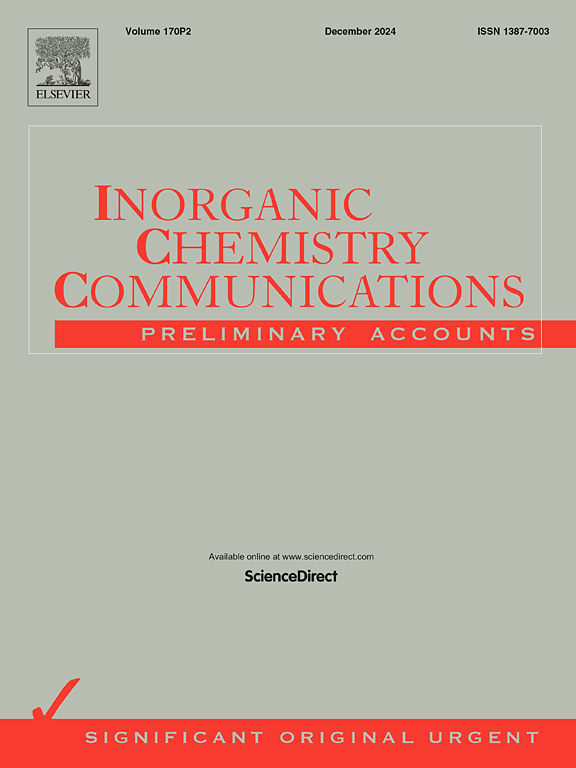对作为生态友好型光伏材料的 CaBS3(B = 锡、锆和铪)铬化包晶的初步原理认识
IF 4.4
3区 化学
Q1 CHEMISTRY, INORGANIC & NUCLEAR
引用次数: 0
摘要
无铅透辉石型材料以其易于加工和可调带隙而著称,已成为制造高效串联太阳能电池的一种具有成本效益的替代材料。本研究利用密度泛函理论(DFT),结合全电位线性化增强平面波(FP-LAPW)方法和修正的贝克-约翰逊交换电位(TB-mBJ),研究了 CaBS3(B = Zr、Hf 和 Sn)化合物作为下一代串联应用的吸收体的潜力。我们的研究结果表明,CaBS3 化合物具有直接带隙的半导体特性。本研究调查了 CaBS3 包晶石的独特性质,揭示了它们提高下一代光伏设备效率的潜力。我们的研究结果表明,CaZrS3 的塞贝克系数高达 3200 μV/K,显示出卓越的 p 型传导性和更高的热电效率。此外,这些材料的直接带隙和双极性导电行为使其成为光伏应用的有力候选材料。值得注意的是,由 CaZrS3 和 CaSnS3 组成的四端串联太阳能电池配置在吸收体厚度为 500 nm 时达到了 55.5% 的峰值转换效率,超过了传统的肖克利-奎塞尔极限。这些结果凸显了 CaBS3 包光体在推进可再生能源技术方面的巨大潜力,为太阳能解决方案的创新设计铺平了道路。这项研究为串联电池设计的优化提供了实证依据,从而推动了下一代光伏技术的发展。本文章由计算机程序翻译,如有差异,请以英文原文为准。
First principle insight of CaBS3 (B = Sn, Zr and Hf) chalcogenide perovskite as eco-friendly material for photovoltaics
Lead-free perovskite-type materials, renowned for their easy processing and tunable bandgaps, have emerged as a cost-effective alternative for fabricating high-efficiency tandem solar cells. Utilizing density functional theory (DFT) combined with the full-potential linearized augmented plane wave (FP-LAPW) method and the modified Becke-Johnson exchange potential (TB-mBJ), this study investigates the potential of CaBS (B = Zr, Hf, and Sn) compounds as promising absorbers for next-generation tandem applications. Our results demonstrate that CaBS compounds exhibit semiconducting properties with direct bandgaps. This study investigates the unique properties of CaBS perovskites, revealing their potential to enhance the efficiency of next-generation photovoltaic devices. Our findings demonstrate that CaZrS exhibits a remarkable Seebeck coefficient of up to 3200 V/K, indicating superior p-type conduction and enhanced thermoelectric efficiency. Furthermore, the direct bandgaps and ambipolar conductive behavior of these materials position them as strong candidates for photovoltaic applications. Notably, a four-terminal tandem solar cell configuration comprising CaZrS and CaSnS achieves a peak conversion efficiency of 55.5% at an absorber thickness of 500 nm, surpassing the traditional Shockley–Queisser limit. These results underscore the promising capabilities of CaBS perovskites in advancing renewable energy technologies, paving the way for innovative designs in solar energy solutions. This investigation lends empirical credence to the optimization of tandem cell designs, thus catalyzing advancements in next-generation photovoltaic technologies.
求助全文
通过发布文献求助,成功后即可免费获取论文全文。
去求助
来源期刊

Inorganic Chemistry Communications
化学-无机化学与核化学
CiteScore
5.50
自引率
7.90%
发文量
1013
审稿时长
53 days
期刊介绍:
Launched in January 1998, Inorganic Chemistry Communications is an international journal dedicated to the rapid publication of short communications in the major areas of inorganic, organometallic and supramolecular chemistry. Topics include synthetic and reaction chemistry, kinetics and mechanisms of reactions, bioinorganic chemistry, photochemistry and the use of metal and organometallic compounds in stoichiometric and catalytic synthesis or organic compounds.
 求助内容:
求助内容: 应助结果提醒方式:
应助结果提醒方式:


